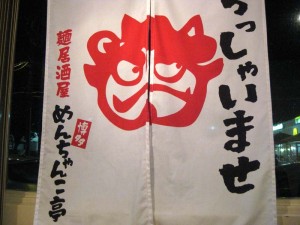 I can’t recall the name of the udon restaurant that occupied the space across Ke’eaumoku Street from HMSA, but after it unfortunately closed and the space went through various unsuccessful iterations, it is now Menchanko-tei. I seem to recall the resident food reviewer at the local newspaper doing a review and going through the history and heritage of Menchanko-tei, so I won’t bother searching for it and just reiterating it here, but if you’re interested, I’m sure this information is a couple of clicks away. Suffice it to say that they specialize in menchanko – a thick noodle ramen, motsu – innards (in this case beef), and tonkatsu – Japanese-style breaded pork cutlets. The two staff members we encountered were both native Nihongo speakers, so this isn’t one of those “Japanese-themed” Korean or Chinese-run establishments where the food looks somewhat right, but doesn’t taste right – this is the real deal.
I can’t recall the name of the udon restaurant that occupied the space across Ke’eaumoku Street from HMSA, but after it unfortunately closed and the space went through various unsuccessful iterations, it is now Menchanko-tei. I seem to recall the resident food reviewer at the local newspaper doing a review and going through the history and heritage of Menchanko-tei, so I won’t bother searching for it and just reiterating it here, but if you’re interested, I’m sure this information is a couple of clicks away. Suffice it to say that they specialize in menchanko – a thick noodle ramen, motsu – innards (in this case beef), and tonkatsu – Japanese-style breaded pork cutlets. The two staff members we encountered were both native Nihongo speakers, so this isn’t one of those “Japanese-themed” Korean or Chinese-run establishments where the food looks somewhat right, but doesn’t taste right – this is the real deal.
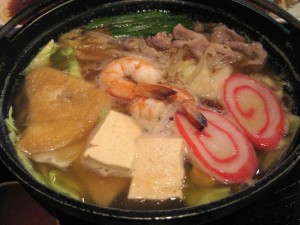 There is a little subtitle on their signage that reads, “Hakata”. To me that screams tonkotsu and Hakata ramen, but apparently that also means innards and fat noodles. The signature menchanko comes in a store-branded nabe (cauldron) with their little oni mascot character on the bottom of the inside, such that he appears when the food is entirely consumed. I’m guessing that this means this is one of many franchises of a chain – maybe the only one outside of Japan? Like other ramen-style noodles, the golden color and the resilient, chewy texture is arrived at by a reaction with the gluten in the wheat flour with alkaline calcium carbonate or potassium carbonate*. The slightly wavy noodles are 2-3mm square – somewhat reminiscent of udon. Garnished with chives (real chives, not scallions), abura-age (fried tofu), cabbage, thinly sliced pork, tofu, moyashi (mung bean sprouts), naruto fishcake, and a pair of shrimp, the noodles themselves are almost completely hidden until you reach in with your chopsticks and disturb the presentation. The soup is light and clear and tastes predominantly like chicken (maybe inspired by mizutaki, a chicken-based nabe from Hakata?) . The abura-age they used was soft and absorbed the soup nicely. It was almost stretchy in the mochi sense. The shrimp had an obvious “product previously frozen” low-bidder taste, and one had a packed poop-channel the size of coat hanger wire. The pork added a nice taste to the mix. I’m glad that there wasn’t a whole lot of bean sprouts since I hate those. Even with the soup’s rich flavor, it was apparently not very salty, since I didn’t get bloaty or have to piss like a racehorse afterwards. This gets points in my book, because that means they actually loaded the stock with quality ingredients, rather than extending the flavor with salt. Overall, I give it a B+
There is a little subtitle on their signage that reads, “Hakata”. To me that screams tonkotsu and Hakata ramen, but apparently that also means innards and fat noodles. The signature menchanko comes in a store-branded nabe (cauldron) with their little oni mascot character on the bottom of the inside, such that he appears when the food is entirely consumed. I’m guessing that this means this is one of many franchises of a chain – maybe the only one outside of Japan? Like other ramen-style noodles, the golden color and the resilient, chewy texture is arrived at by a reaction with the gluten in the wheat flour with alkaline calcium carbonate or potassium carbonate*. The slightly wavy noodles are 2-3mm square – somewhat reminiscent of udon. Garnished with chives (real chives, not scallions), abura-age (fried tofu), cabbage, thinly sliced pork, tofu, moyashi (mung bean sprouts), naruto fishcake, and a pair of shrimp, the noodles themselves are almost completely hidden until you reach in with your chopsticks and disturb the presentation. The soup is light and clear and tastes predominantly like chicken (maybe inspired by mizutaki, a chicken-based nabe from Hakata?) . The abura-age they used was soft and absorbed the soup nicely. It was almost stretchy in the mochi sense. The shrimp had an obvious “product previously frozen” low-bidder taste, and one had a packed poop-channel the size of coat hanger wire. The pork added a nice taste to the mix. I’m glad that there wasn’t a whole lot of bean sprouts since I hate those. Even with the soup’s rich flavor, it was apparently not very salty, since I didn’t get bloaty or have to piss like a racehorse afterwards. This gets points in my book, because that means they actually loaded the stock with quality ingredients, rather than extending the flavor with salt. Overall, I give it a B+
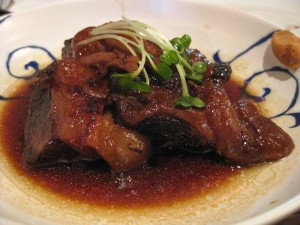 For a starter, Root and I split their kurobuta kakuni (braised black pork belly). It looked really good, and the quantity was large for the $9.95 USD price. The taste was on the sweeter side, and there was a hint of something miso-ish or maybe anise-ish. One of the two chunks I had broke apart easily, but unfortunately, the other was tightly seized. The fatty parts were of course luxuriantly moist and juicy, but the meaty parts of both pieces were actually dry – even the one that fell apart easily. Maybe it wasn’t cooked quite long enough, or I got the piece that was on top that was not fully submerged in liquid that got all dried out. Breaking the meat apart and dipping it in the braising liquid made it mostly better. There was some nice onion relish hidden under the pile of meat too. I give it a C+.
For a starter, Root and I split their kurobuta kakuni (braised black pork belly). It looked really good, and the quantity was large for the $9.95 USD price. The taste was on the sweeter side, and there was a hint of something miso-ish or maybe anise-ish. One of the two chunks I had broke apart easily, but unfortunately, the other was tightly seized. The fatty parts were of course luxuriantly moist and juicy, but the meaty parts of both pieces were actually dry – even the one that fell apart easily. Maybe it wasn’t cooked quite long enough, or I got the piece that was on top that was not fully submerged in liquid that got all dried out. Breaking the meat apart and dipping it in the braising liquid made it mostly better. There was some nice onion relish hidden under the pile of meat too. I give it a C+.
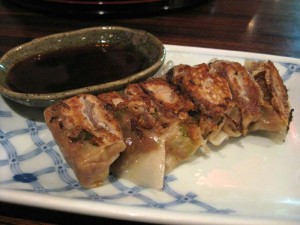 We also split an order of gyoza. The menu description described them as small, and they were indeed. That’s not to say they were lacking in filling – they were practically all filling. The skin was so thin that they tended to tear when the stuck-together stick of 6 gyoza was pulled apart. There was some kind of meat in there – I’m guessing pork since that is traditional – but you wouldn’t know it from the garlic and chives in there. Wham! It was like being hit in the mouth by the garlic bus. I give them an A-.
We also split an order of gyoza. The menu description described them as small, and they were indeed. That’s not to say they were lacking in filling – they were practically all filling. The skin was so thin that they tended to tear when the stuck-together stick of 6 gyoza was pulled apart. There was some kind of meat in there – I’m guessing pork since that is traditional – but you wouldn’t know it from the garlic and chives in there. Wham! It was like being hit in the mouth by the garlic bus. I give them an A-.
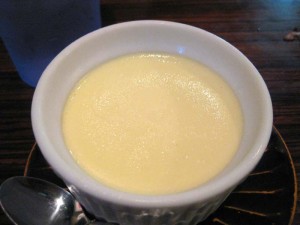 I had a little room left for dessert, so I tried their special “organic” pudding. It was very good, but I don’t really think the organic appellation on the eggs and milk really made the difference: Good quality ingredients regardless of their organic production made the difference. The pudding was lightly sweetened, so it was more an adult taste. They didn’t turn it out of the ramekin it was made in, so the caramel sauce was hidden at the bottom. I liked it more than Azteca’s flan! This one gets an A.
I had a little room left for dessert, so I tried their special “organic” pudding. It was very good, but I don’t really think the organic appellation on the eggs and milk really made the difference: Good quality ingredients regardless of their organic production made the difference. The pudding was lightly sweetened, so it was more an adult taste. They didn’t turn it out of the ramekin it was made in, so the caramel sauce was hidden at the bottom. I liked it more than Azteca’s flan! This one gets an A.
Recommended
Three out of four noodley monkeys
*back in the postwar days, caustic soda (sodium hydroxide/lye) was used as a substitute due to shortages. Although caustic soda alone is a potential health hazard, when reacted out with the gluten during kneading, it is rendered inert, and the resulting food product is safe. A lot of old-timers remember the distinct taste that the caustic soda imparted to the noodles.
0 Responses to “Menchanko-tei”